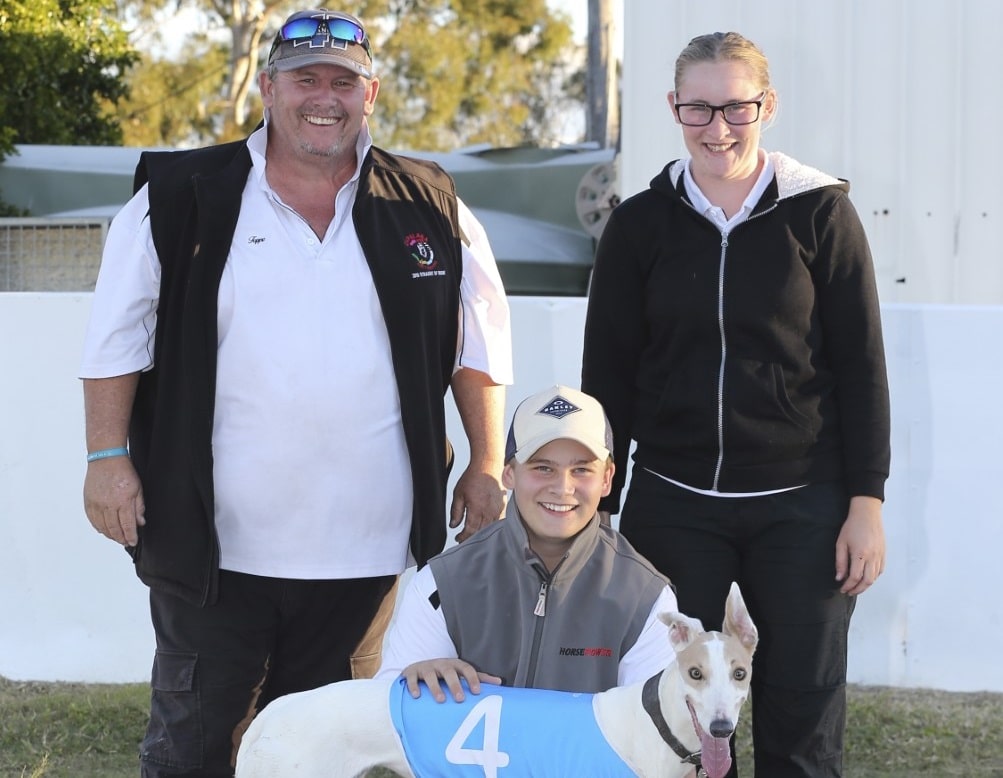
Caption: Lockrose (west of Brisbane)-based trainer Shane Topping with his teenage children Jordan and Cooper and sprinter Mini’s Girl. (Photo: Just Greyhound Photos)
By MIKE HILL
SHANE Topping admits that a work redundancy package just over 12 months ago was enough to push him into full-time training.
“It was something I’d been wanting to do for several years but I just couldn’t take that final step,” he said.
“The redundancy made the decision a lot easier.
“I decided to give it a go and I’m glad I did.”
Topping, who we feature in this month’s Trainer Column, is based at his eight-acre property at Lockrose, west of Ipswich, in south-east Queensland.
He has 14 dogs in work and is happy with his progress so far.
Early last month he was sitting fourth on the Ipswich male trainers’ premiership with 211 points behind leader Peter O’Reilly (337).
His record so far this year is 25 wins, 22 seconds and 28 thirds with a 12 per cent winning strike rate.
He admits he’s been a bit surprised by his recent success.
“I’m happy with my results so far and I’m progressing nicely in my first year as a full-time trainer,” he said.
Heading his team is the Murgatton Syndicate-owned pair Lilly Street (53: 13-7-8) and Jury’s Out (65: 5-7-12) and the Les Bein-owned Bogie Lightning (29: 5-6-5).
Lilly Street has been a consistent performer for the kennel and Topping is hoping the daughter of Aston Dee Bee and Bogie Lilly can maintain her good form when he steps her up to Masters racing.
“She’s reached the age (42 months) when she can move into the Masters division,” he said.
“She could be my Thursday night dog at Albion Park.”
Topping said his teenage children Cooper, 15, and Jordan, 19, enjoyed helping out around the kennels and on race days.
“They have also assisted Shane and Pauline Byers over the years and Greg Board (well-known South Australian breeder-owner-trainer) gave Cooper the sprinter Spring Evie as a ‘thankyou’ for helping the Byers,” he said.
“Jordan also likes to help out when she’s not driving pacers.”
For the family, the pacing bug seems to run deep.
Topping himself drove pacers for several years at the Gold Coast and Rocklea tracks and on the show circuit before moving into greyhounds.
“My grand-parents had thoroughbreds and an uncle trained trotters,” he said.
It was through some mates that he purchased a couple of pups two decades ago and he’s been focused on greyhounds ever since.
Topping, 47, has been training for 19 years, the first 18 as a hobbyist.
Working at an Ipswich engineering firm, he could only race his dogs on the occasional Friday afternoons and at weekends.
“I only ever had four to six dogs in work at any one time,” he said.
“I had some success with my bread and butter dogs and they taught me a lot.
“Hopefully, with more time to give to my dogs I can develop a much stronger team in the future.”
Over the years several of his dogs have qualified for feature finals ‘but I haven’t yet cracked it’.
“I’d love to get a Group dog,” Topping said.
He is currently waiting for his former racer Ten Gallon Hat (Glen Gallon-Hatinator) to whelp a litter.
Topping said the brindle bitch, with a record of six wins and 29 placings, was in pup to Don’t Knocka Him.
1: How and when did you get involved in greyhound racing?
A: It was about 20 years ago when a couple of mates from harness racing and I bought a couple of pups.
2: Who has been the greatest influence on you as a trainer?
A: It would have to be Dale Mortimer. He raced his dogs at Ipswich and the old Gabba track.
3: At what age do you start preparing a pup for racing?
A: I like to start when they are about 15 months old.
4: How long does it take to prepare a pup for its first race?
A: It all depends on the pup. It can take anything between three and six months depending on the maturity of the dog.
5: What makes a good pup?
A: One with a good nature and good breeding.
6: Do you do anything special when preparing a young dog for its maiden compared to a seasoned performer?
A: No, I treat them all the same. As part of their pre-race preparation I will trial them with some of the race dogs I have in my kennels.
7: Do you have a set routine for all your greyhounds or do you vary training for individual runners?
A: It’s all the same. They all go on the walker for 20 minutes and then into an acre and a half paddock before coming back into their kennels.
8: Do you have any unique or unusual methods you would like to share in regard to training?
A: No, but I like to work the younger dogs with older ones, letting them get used to the hustle and bustle and copping bumps that they’ll face later in racing.
9: Do you swim your dogs as part of your training regime?
A: Not as part of training, but in summer I let them exercise in a three-acre paddock that has a dam. They’ll run and swim … it helps to break up their routine.
10: How frequently do you like to race your dogs?
A: Once a week.
11: What’s your training routine for dogs between races?
A: Each day they go on the treadmill for 20 minutes.
12: Do you do all muscle work on your dogs and treat all injuries?
A: Yes, I do my own muscle work.
13: Do you do treat all injuries to your dogs yourself?
A: I treat most injuries, about 95 per cent of them and I use a vet for the other five per cent.
14: Which is the best greyhound you have trained?
A: An old dog call Staminator … he finished his racing with a record of 11 wins and 35 placings and the sprinter Farmor In Tune… he gave me my first Thursday night winner and my daughter Jordan handled him for her first Thursday night winner as well. It made for a emotional win and he was a giveaway.
15: What do you consider is the best greyhound track in Australia and why?
A: Of the tracks I’ve raced at, I would have to say the new Grafton circuit is pretty good.
16: What does the industry need most going forward?
A: The new complex at Purga. With three tracks – a straight track, a one-turn track and a two-turn track – it’s going to be ideal for all dogs. Dogs will be able to race on tracks that suit their ability.
17: What is the best advice you could give someone just starting out as a trainer?
A: Talk to as many trainers as you can and put into practice the information you are given.









